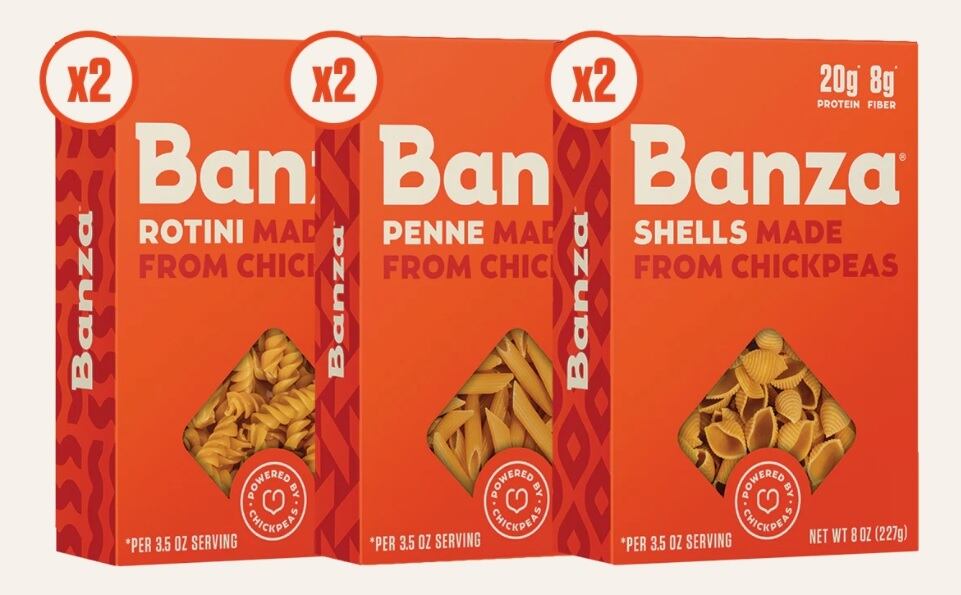“Refined grain categories represent well over $100bn in the US, and we believe a legume-based version can be 10%+ of each of those categories,” Banza Chief Operating Officer Mike Tarullo told FoodNavigator-USA.
He explained this belief is based partly on Banza’s ability to capture 10% of the total pasta category at some leading retailers with its chickpea-based options, which range from basic elbows to trendy cascatelli and include a variety of boxed and microwavable mac and cheese options that are both dairy- and plant-based.
“Banza has grown more than three times over the last three years. We’re in over 20,000 stores and most of our growth has been in same-store sales. At some leading retailers, our share of the total pasta category is above 10%. We’re excited to be proving that a legume-based alternative can be 10%+ of a refined grain category,” he said.
A multi-media, values-based marketing approach
Banza’s strong, steady growth begins with taste and offering products that align with modern consumer values, which are then magnified across multi-media, Tarullo said.
“Our job, and everyone’s in better-for-you food, is to get people to eat healthier, more sustainable options. This starts with making sure BFY foods taste like the ones we’re used to, especially when we’re talking about some of our most loved meals like pasta,” he said.
The next step is spreading the word, which Banza does through social channels by working with creators to “celebrate our universal love for these foods” and showing how people can enjoy them without guilt, he said.
This approach “has contributed to over 10,000 creator mentions on Instagram and TikTok in the past year. We’ve also been fortunate to see celebrities we love using our products, like Kristen Bell, Lizzo, Drew Barrymore and Emmy Rossum,” said Tarullo, who added in these communications Banza is “proud to let our fans describe how Banza fits into their lives versus doing loud marketing ourselves.”
This approach also has helped the brand “break through with Millennials and Gen Z, both of [whom] we over-index with,” added Tarullo.
‘We want to change … more categories – not just borrow share from existing BFY brands’
Given Banza’s success so far, Tarullo said, the company doesn’t want to stop with pasta.
“We want to change all of pasta, pizza, mac and cheese, and more categories – not just borrow share from the existing [better-for-you] brands.”
The company already has expanded into rice and pizza, both made from chickpeas.
Its rice line is smaller than the others with a trio of offerings including plain, chipotle tomato and garlic olive oil.
It’s pizza line includes frozen offerings that range from a naked chickpea-based crust to the same crust topped with classic options that are both animal- and plant-based.
“Using chickpeas as our key ingredient helps to achieve the taste and texture people expect from pasta and pizza. This has kept people coming back after giving our products a try. In Q4 ’22, Numerator data showed we had the #1 repeat rate in BFY pizza, which is something we’re super proud of,” Tarullo said.
He added the company’s pizzas and pastas also are gaining traction in foodservice where its chickpea-based crust has replaced cauliflower crust in chains including Oath and Modern Market.
“We’ve also added our pasta to the menu of all Emmy Squared restaurants, and at college campuses like Boston College, NYU, and Yale,” he said, adding, “We’re grateful to all our partners for taking a chance on us and are thrilled to see it paying off – and we’re certainly looking for more!”
The products also perform well in e-commerce, where Tarullo says Banza sees about two times the category share versus in store, “mostly because we can get our fair share of shelf space there.”
Banza sees ‘a lot of room for impact’ on the health of people, the planet
As Banza expands its portfolio and reach, Tarullo said the company is eager to see consumption of legumes climb – not just for the health of its consumers, but the planet as well.
“Nearly all of the US is eating more than the recommended amount of refined grains. Studies have shown that this is correlated with a host of negative health outcomes, like greater risk for heart disease (33%) and diabetes (28%). So, we make our foods with beans instead,” said Tarullo, noting that “eating beans is correlated with reduced risk of heart disease (22%) and diabetes (35%), according to NIH.”
USDA also estimates that 80% of the US population doesn’t eat enough beans, “so we have a lot of room for impact,” he said.
Chickpeas also are “uniquely good for the environment,” which is a story that consumers increasingly care about, Tarullo said.
“Chickpeas can grow in drought-prone areas, which means they require 2x-9x less water than other protein sources like milk, beef, eggs and poultry. Chickpeas and other legumes also restore soil health,” as they are one of the only crops that are nitrogen fixing, which reduces the need for carbon-heavy soil management, he added.
To better understand these benefits and share this story with consumers, Banza has partnered with the Soil Carbon Initiative a new program from the nonprofit Green America, which is dedicated to regenerative agriculture transition.
“Knowing the impact chickpeas and regenerative farming can have on our health and the planet, our hope is this partnership gets us one step closer to making them a bigger part of our agricultural system and bringing our mission to life,” Tarullo added.

